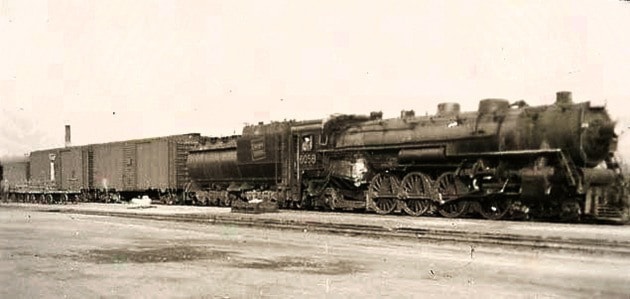Eleanor Deckert
PART ONE: A re-enactment – Thursday, May 28, 1942, 3 p.m., Mile 34
CNR engine 6058, the eastbound daily ‘Number 2’ scheduled for Wednesday, May 27, was delayed by repairs to a bridge near Mile 34, which had been damaged by the spring runoff.
Over 24 hours late, on Thursday afternoon the engineer had orders to proceed.
Superintendent Gough was on board and with him enjoying the sights through the windows of the observation car were officials from the National Film Board of Canada (a division of the War Services Department) and several representatives of a Hollywood film company. In the other passenger cars local residents returning home to Blue River, long-distance travellers destined for Toronto, sightseers from the USA and the usual train crew staff.
At the controls of the Thursday daily passenger train, CNR engine 5123, a second ‘Number 2,’ was D. A. (Stub) McKenzie. He was instructed to follow the first ‘Number 2’ at 35 miles per hour, the usual speed, leaving a 20 minute interval between them. Without a speedometer, like other engineers at the time, he measured with his pocket watch how much time it took to pass the telegraph poles and calculated his rate of speed knowing that is was always 40 poles to one mile.
Without a radio, like other engineers at the time, he had only the last train orders he received from the telegraph operator at the last station to tell him what he was to do.
After the delay, messages had to be conveyed to each train. Attempting to return to normal schedules after such a complex interruption took a lot of coordination.
Since the beginning of World War II, trains were being used to move young soldiers headed towards Europe. Fresh recruits filled the Thursday ‘Number 2.’ Norman Moxness was serving in the air force, travelling to Edmonton. He didn’t know his life would be in danger on May 28, 1942.
3:35 p.m., Avola Train Station
Engine 6058 required more water for its boiler after such a long delay. The Avola Station water tower at Mile 24.8 was a necessary stop. The dining car was late with lunch or early with the evening meal and weary travellers were making their way forward from the tail end observation car.
At the head-end, new train orders for the engineer were available from the telegrapher at the Avola Station. Brakeman Kelly stepped off the rear-end to routinely walk back along the gently curved tracks with red flags to ‘protect the train.’
Up the hill in Avola, Thomas and Agnes Craig were about finished planting their large vegetable garden. Their daughters Vernetta, Evelyne, Molly and Bernice, were just home from school.
Royce Gibson, a 17-year-old who lived right beside the tracks, and his buddies, Ivor and Elmer Lundeburg, knew all about the trains. On-time or late, there were usually about four freight trains per day and two passenger trains each way. On Monday, Wednesday and Friday the boys made a point of meeting the Way Freight coming from Kamloops with local stops to deliver groceries, mail, coal, grain and shopping orders from catalogues. On Tuesday, Thursday and Saturday, the same train returned from Blue River south to Kamloops making stops at each town and section crew headquarters. The boys knew the names of the engineers and crew and repeated stories they heard. One train travelled from Wire Cache to Avola (a distance of 5.2 miles) in three minutes! That calculates to be a speed of about 75 miles per hour! Another tale of unusually high speed that the boys told was of a train going from Avola to McMurphy (a distance of nine miles, much of it curved track) in 13 minutes.
Ever alert to the train whistle signals, the boys knew the meanings of the short and long blasts used to communicate between the front and rear end of a train, to the station master, warning forward or reverse movement, and to let workers know to begin or finish their assignments. On this particular afternoon, Royce was riding on a wagon with his dad, on their way to Messiter to finish a logging project.
Thursday, May 28, 1942, 3:52 p.m.
Superintendent Gough had been talking to Gordon McKenzie, both riding in the observation car at the end of the train. When the train stopped he stepped out the door and looked around the curve to see the tender at the head-end of the train taking on water. Behind the train, he could see Brakeman Kelly walking back around the curve with his red flags.
Unexpectedly, one long blast was heard signalling the approach of a train just passing the one-mile board before the station! Kelly started to run, waving frantically. Seated on the right side of the engine cab, the counter-clockwise curve of the tracks blocked Engineer McKenzie’s view of the stationery train. Brakeman Kelly’s flags would be his only warning.
But the flags were only 10-15 car lengths down the track when the second ‘Number 2’ passed Kelly.
Engineer McKenzie saw the flags, shut off the steam valves, set the brakes and, realizing the collision was inevitable, jumped off.
Continued next week –
Below: CNR Number 5123 was pulling the second passenger train. The Pacific class 4-6-2 type was a standard, common engine of its day. This engine was repaired after the accident and was in service until the 1950s. Photo submitted

